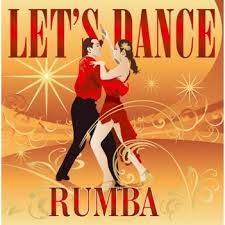The modern international style of dancing the rumba grew out of studies made by dance teacher Monsieur Pierre (Pierre Zurcher-Margolle), who partnered Doris Lavelle. Pierre, then from London, visited Cuba in 1947, 1951 and 1953 to find out how and what Cubans were dancing at the time.
The International Ballroom Rumba is a slower dance of about 120 beats per minute which is similar, both in music and in dance, to what the Cubans called the bolero-son.
No social dances in Cuba involve a hip sway over the standing leg and, though this is scarcely noticeable in fast salsa, it is more pronounced in the slow ballroom rumba. Steps are kept compact and the dance is danced generally without any rise and fall. The basic figures derive from dance moves observed in Havana in the pre-revolutionary period, and have developed their own style since then. Competition figures are often complex, and this is where competition dance separates from social dance.
